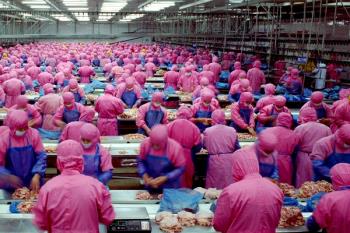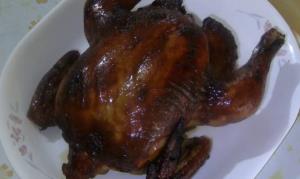 According to USDA-FAS GAIN Report CH2020-0040, dated March 27th, production of chicken in China will attain 15.750 million metric tons (34,650 million pounds). Total imports will attain 675,000 metric tons or four percent of total supply. The USDA estimates that for 2020 imports will increase by 16 percent over 2019. Exports are relatively small representing 2.2 percent of total supply. Accepting a population of 1.4 billion, per capita consumption in China is 11.5 kg (25.3 pounds).
According to USDA-FAS GAIN Report CH2020-0040, dated March 27th, production of chicken in China will attain 15.750 million metric tons (34,650 million pounds). Total imports will attain 675,000 metric tons or four percent of total supply. The USDA estimates that for 2020 imports will increase by 16 percent over 2019. Exports are relatively small representing 2.2 percent of total supply. Accepting a population of 1.4 billion, per capita consumption in China is 11.5 kg (25.3 pounds).
Pork is the principal animal protein comprising 65 percent of the total consumed. This is followed by poultry at 45 percent, beef, six percent and other species, four percent. The consumption of chicken is sub-divided among conventional white broilers at 45 percent, traditional “yellow birds” at 30 percent and a hybrid between conventional broilers and traditional birds termed “817” now comprising 15 percent. Culled hens producing eggs represent ten percent of chicken consumption. It must be remembered that in China ducks are consumed in both rural and urban areas. In addition to chicken 3 to 4 million metric tons of duck and other poultry is consumed annually.
 The advent of African swine fever reduced the supply of pork possibly by as much as 25 percent although herds are being slowly rebuilt and processed pork from the EU and the U.S. is now supplementing domestic production. The effect of African swine fever is noted by an estimated 35 percent decrease in domestic production from 2018 through 2020.
The advent of African swine fever reduced the supply of pork possibly by as much as 25 percent although herds are being slowly rebuilt and processed pork from the EU and the U.S. is now supplementing domestic production. The effect of African swine fever is noted by an estimated 35 percent decrease in domestic production from 2018 through 2020.
In November 2019 the embargo on U.S.-origin poultry products imposed during the HPAI outbreak in 2015 was lifted in accordance with the General Administration of Customs of China Announcement #177. Although shipments to China were impacted by port congestion and transport disruption arising from COVID-19 during the first quarter, during the first four months of 2020 the U.S. exported poultry products amounting to 99,875 metric tons valued at $143.9 million. This represented an 8.5 percent of volume and 11.8 percent of value exported but with a unit price of $1,440 per ton. Although China ranked second among importers of broiler parts and feet combined over the first third of 2020, it is noted that the volume shipped to Hong Kong declined over the same period by almost half so the net export gain for the U.S. from China was effectively 57,309 metric tons of mixed parts and feet. The U.S. was indirectly supplying China after the 2015 embargo through a grey market channel from Hong Kong to the mainland.
 Factors that will influence exports to China include government policy on tariffs, availability of pork and the ability of the U.S. to supply products consistent with consumer requirements. As of March 2020, tariffs comprising 35 percent on average, plus a weight-based duty have priced muscle cuts out of the market. Tariff exclusions have since been applied to U.S. products allowing some importers to be granted an exemption from Section 301 retaliatory tariffs. According to the USDA, the most popular products include livers, feet and some frozen chicken cuts. Traditional U.S. exports comprising leg quarters will not have a strong competitive advantage over domestic chicken and imports from Brazil and the E.U. Importers favor U.S. feet, in addition to wings and wing tips that are used in snack foods.
Factors that will influence exports to China include government policy on tariffs, availability of pork and the ability of the U.S. to supply products consistent with consumer requirements. As of March 2020, tariffs comprising 35 percent on average, plus a weight-based duty have priced muscle cuts out of the market. Tariff exclusions have since been applied to U.S. products allowing some importers to be granted an exemption from Section 301 retaliatory tariffs. According to the USDA, the most popular products include livers, feet and some frozen chicken cuts. Traditional U.S. exports comprising leg quarters will not have a strong competitive advantage over domestic chicken and imports from Brazil and the E.U. Importers favor U.S. feet, in addition to wings and wing tips that are used in snack foods.
Currently Brazil is the dominant exporter to China with approximately 75 percent of the market in 2019 amounting to 450 tons. Argentine and Thailand shipped approximately 60,000 and 50,000 tons respectively.
Before the U.S. industry regards China as an immediate and vast market the realities should be considered both with respect to product mix and potential export volumes.